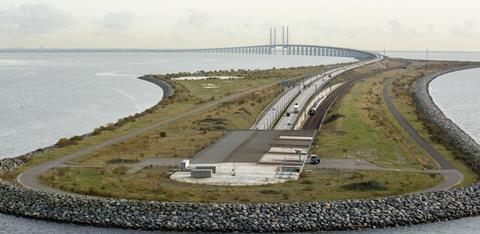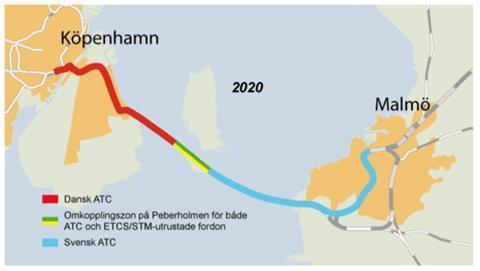
EUROPE: Test running on the Øresund fixed link with an ETCS-equipped Vectron locomotive from Siemens Mobility has successfully validated the use of ERTMS onboard equipment for cross-border operation between Sweden, Denmark and Germany.
The link is fitted with a mixture of Swedish and Danish signalling and electrification systems. There is a signalling transition zone on the Peberholm artificial island between the ZUB 123 train control system used in Denmark and the Swedish ATC-2. The trials were undertaken to ensure that a locomotive could transition satisfactorily between the two Class B systems using its ETCS onboard equipment.

The Vectron was equipped with a Trainguard200 onboard unit meeting the latest UNISIG Baseline 3 specifications, together with Specific Transmission Modules to communicate with each of the legacy systems. The onboard unit and STMs had previously been validated with a series of test runs on Sweden’s Västkustbanan in 2016-17. During these trials, the locomotive was operated at up to 200 km/h using a lineside installation that had been configured to represent the signalling interface on the fixed link.
The subsequent tests on the bridge itself were organised by the Øresundsbro Konsortiet in co-operation with infrastructure managers Trafikverket and Banedanmark and Siemens Mobility. The objective was to validate the lineside installations that manage the signalling transition, as part of the process to authorise the future operation of ETCS-fitted trains over the link.

‘To have ERTMS installed on the Øresund Bridge is an important step for us, but also for the rest of Europe’, said Øresundsbro’s Head of Rail Rolf Sundqvist when the result of the trials was announced on February 10. ‘Trains crossing the bridge are not only crossing the strait, but they are also crossing the border. We will be able to facilitate much smoother cross-border train operation going forward.’
Explaining that the partners ‘were able to perform the test runs despite the Covid-19 limitations’, Siemens Mobility’s CEO for Rail Infrastructure Andre Rodenbeck added that ‘the successful test demonstrates that we have the technological know-how to develop train control systems and locomotives for cross border operation’.

















